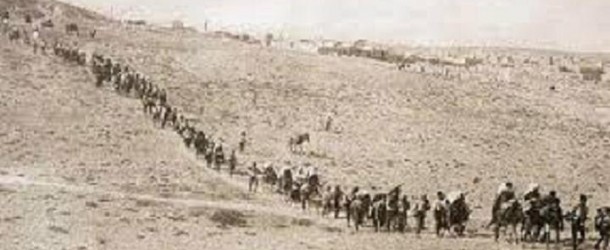Inter-war era can be observed as rise of authoritarianism in most of the countries of the Europe. However, one region pops right up to our mind is Balkans; being vulnerable and open to intervention. In the brink of the Second World War, Balkan states had tended to found them as authoritarian regimes. Whereas the regimes in the Balkans gave a way to rising authoritarianism, other relatively developed states in Europe, like Germany and Italy, were governed by fascist and social-nationalist parties. In this paper, I am going to compare the regimes of Balkan states while trying to make a link with those tendencies to the population exchange between Greece and Turkey.
After the First World War, Turkey, then Ottoman Empire, had faced a threat of being disintegrated by the Allied Powers. Treaty of Sevres had sentenced Turkey that a new Armenian, Kurdish states to be formed and other than central territories of the Empire had ought to be controlled by the Allied Powers. The little and unorganized resistance to Sevres was in the picture till the famous invasion of İzmir by the Greeks. Since Greeks were the early subject and first ones that achieved to claimed an independence from the glorious Empire, the notion of this ex-subject being able to invade one of the main cities of Turkey had created an enormous reaction within the Turks. Under the leadership of Atatürk, Turks had unified their pre-existing local groups and formed an organization called Society of Defense of Rights of the Anatolia and the Rumelia and win the war basically through the Grand Assembly, which was the predecessor of the congress and societies.
The success of being able to rescue the lands through congress and slightly democratic institutions diverges from nearly all Balkan states. According to Ergun Özbudun, the author of “The nature of Kemalist political regime”, we should seek the legitimization and the notion of the single-party regime in the early years of the republic, in the early institutions of the Turkish War of Independence. The transformation of the Society of the Defense of Rights of the Anatolia and Rumelia to the First Grand National Assembly amidst the Greek-Turkish War was significant in its own way, especially if we think that the Balkan states’ being easily turn into autocracies due to increasing international tensions.
According to Özbudun, RPP, first and the only party of the single-party era of modern Turkey, had its pluralistic characteristics from the early experience of the Society of Defense and Rights, which enables the inclusion people from the different backgrounds. While states in the Balkans suffered from transferring their regimes from authoritarian to democratic ones, Turkey able to transfer its regime to multi-party democracy by the help of this pluralistic notion of decision making during the Independence War.
According to Barbara Jelavich, the author of the “Balkan authoritarian regimes: the outbreak of World War II”, suggests that internal politics of the Balkans were deeply affected by the Great Depression and the rise of European dictatorships. Soviet influence on the one hand and Italian expansionism on the other, tendencies to authoritarian regimes affected the political spheres of the Balkans as well.
As mentioned above, because of the Great Depression, Balkan states and Germany had come to understanding on trade. Germany had high added value industrial commodities that could not sale, and Balkan states were rich on raw materials and agricultural products. This was the perfect match, if we appreciate that neither of the parties had money to do trade, they chose to organize couple of barter agreements. By the end of 1938, Germany had had the upper hand in Balkan politics due to her trade relations. In those years Germany was the leading partner, while imports proportion of products in Bulgaria was 37.9 percent, 31.1 percent in Greece, 50 percent in Yugoslavia, 48.5 in Romania. If we look to the exports, 63.6 percent of the Bulgarian, 43.2 percent of the Greek, 49.9 percent of the Yugoslavian and 35.9 percent of the Romanian products sold to the Germans.
Despite the economic dependencies and prestigious state of Fascist and German Nazis’ linked to their foreign policy victories, General Metaxas, who was the Greek dictator, the only Balkan leader that had resemblance to fascist leader of Europe. Besides Metaxas, Romanian Iron Guard also had some attributes of a fascist party but still it held mainly nationalistic manners and too much Romanian in this sense. According to Jelavich, one main reason in order to differ Balkan autocrats from fascists was the decision making process and mentality of the fascist parties. In Balkans, the monarchs and their entourage seemed to be responsible for the politics while in fascist regimes there were a strong party and leadership in order to make decision for countries sensitive issues. Apart from Greece, which was ruled with by a parliament for a time period, all Balkan states were experiencing royal dictatorships, by the words of Jelavich. Although, Balkans were influenced by Italian and German politics, there were never huge masses to insist big system changes like in German, Italian and Russian cases. As a matter of fact the big portion of society was never interested in politics and we can say that they were relieved by the coups and regime oppressions. There is no clue that if oppressive authoritarians were not in charge, liberal constitutional government would flourish in Balkans during 1930s.
Lack of popular mobility in Balkans might resemble to Turkish case, however, unlike the Balkans, legitimacy of decision making process was coming from the constitution and being used by the Grand National Assembly which makes it the superior decision making organ. According to Yaprak Gürsoy, the author of “The Effects of the Population Exchange on the Greek and Turkish Political Regimes in the 1930s”, due to the population exchange of late 1920s, Turkish political elite had left unchallenged. In order to understand this theory, we might look into the notion of the population exchange between Greece and Turkey. After the Lausanne Treaty, two belligerent parties decided on homogenize their population. Two states exchanged Turks or Muslims living in Greece, not the ones living in Western Thrace, and the Greeks or mainly Greeks speaking subjects living in Western Anatolia. This exchange changed the politics handsomely in related countries apart from being very traumatic for the refugees. While Greeks who were subjected to migrate were mostly merchants and businessman, Muslims who were subjected to migrate were farmers, agrarians. According to Gürsoy, young Turkey had lost their bourgeoisie class with this exchange and lack of business elite had helped significantly to RPP, and ruling coalition of political and military elite in order to govern Turkey more easily without being experiencing serious threat and opposition. However, unlike in Turkish case, population exchange contributed to the weakening of the ruling elite in Greece. Since newcomers were merchants and businessmen, they tended to meddle into politics more than others. Refugees were come into middle to the sensitive balance of royalists and republicans in Greek politics, and they did a few additions to the future of it.
First of all, Greeks coming from Anatolia were in favor the Venizelist party, at least in their first years, and resented to the royalists. They were thinking that the king and this particular group of tzakia politicians were the responsible of the Asia Minor catastrophe, a.k.a loss in the Turkish-Greek War, which caused them to forced emigration. Besides, the first years of war was progressing well under the Venizelos rule after all. In addition to this, refugees which had settled on Northern part of Greece had opportunity to reside on the lands Turks had left and others to settle into the cities which became workers in industries that used to. Basically Venizelos had given them a second chance in order to live a satisfactory life, mostly in economic manners. However, circumstances had changed within time and refugees faced to isolation from their own nation plus their living standards deteriorated because of the Great Depression. In this point we see the rise of communism within the Greeks mainly ones who lived in cities, and mass mobility as well. In 1930s Greece was dwelling with huge strikes and riots. Most rioters were the tobacco workers, which were working side by side and influencing their opinions on government. According to Gürsoy, half of the tobacco workers were refugees and due to the turbulent pattern in Greece General Metaxas staged a coup in 1936, with the permission of the king of course.
Balkans, as constitutes one of the serious conflict zones tends to have similarities with Turkey in some ways. Whereas, Turkey being labeled as a Balkan state, the democratic evolution of Turks a little different than their Balkan counterparts. In this paper I tried to analyze autocratic regimes in Turkey and Balkans during 1930s while linking Turkish and Greek politics to population exchange after the Lausanne Treaty. Balkan states were mostly effected by the influence of Italian fascism and German Nazism to some extent and also expansionist threats severely caused to authoritarianism to flourish in Balkans. In spite of trade partnership between Germany and Balkan states were solid, regimes were not originated from the same source. Since rise of communism was also a threat to then regimes of Balkans, this sensitive notion had led to coups and iron-fist autocrats. Population exchange between Turkey and Greece also contributed to the authoritarians vis-à-vis in Greece and Turkey in different ways. While population exchange had help Turkish elites to left unchallenged, Greeks dominant groups were faced serious threats and refugees had helped to rise of communism, which led to authoritarianism again eventually.
Basri Alp AKINCI
REFERENCES
- Özbudun, Ergun, “The Nature of the Kemalist Political Regime” in Kazancigil & Özbudun (eds.), Atatürk, Founder of the Modern State, London: C. Hurst, 1997, pp. 79-102.
- Jelavich, Barbara, “Balkan authoritarian regimes: the outbreak of the World War II”, History of the Balkans, Vol. 2, Chapter 6, pp. 192-238.
- Gürsoy, Yaprak, “The Effects of the population exchange on the Greek and Turkish political regimes in the 1930s”, East European Quarterly, XLII, No: 2, 2008.
























































